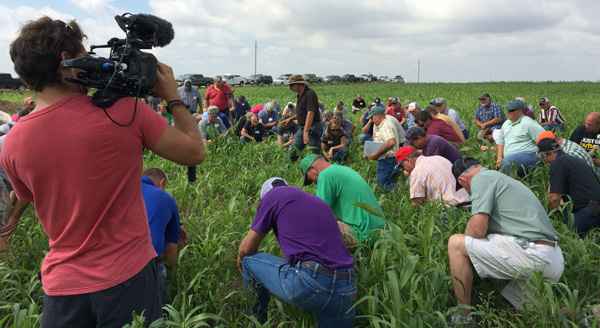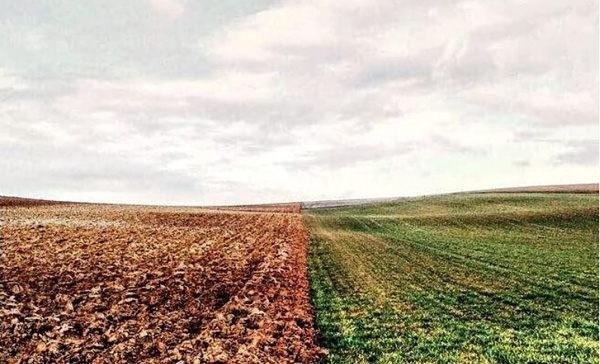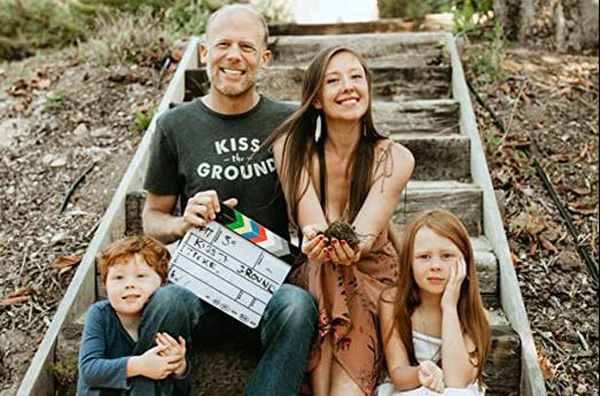Josh and Rebessa Tickell talk about finishing and grading their feature length documentary on soil ‘Kiss the Ground’, seven years in production, to meet Netflix UHD requirements.

Feature length documentary ‘Kiss the Ground’ draws attention to a new approach to farming called regenerative agriculture, which has the potential to rebalance the climate, replenish water supplies and feed the world. Filmmakers Josh and Rebecca Tickell have already produced 14 films on environmental topics and been involved in climate change activism over many years.
Josh Tickell said, “After two decades of doing this work, we felt we were hitting a wall with the global climate conversation. It was clear to us that we had lots of data on the problem, but very little actionable data on the solution.” Soon their friends started trying to convince them that their next project should be about soil. “Once we saw the data of how much carbon soil can hold, we were convinced and began a seven year journey to make this movie.”
Integrating the Years
The essential challenge of the film was to capture, over a number of years, numerous interviews and footage from around the world, while also incorporating various third party footage, animations and visual effects, all of which needed to integrate. “We were committed to creating a very cinematic experience,” said Josh. “It’s tough to do on a tight budget and we knew a lot would come down to post and colour. DaVinci Resolve Studio was instrumental in giving the look the consistency it deserved.”

With many versions of the film forming throughout the years, the team used their editing software to maintain a current look using existing colour tools. Once the film reached a final cut, the massive job of reconforming in DaVinci Resolve Studio began. “Going back to the original master footage was brutal, because we had been slowly adjusting the film’s look for seven years. Suddenly, we had to start from scratch. But Resolve gave us very deep control over the various aspects of it,” Josh said.
Unlike narrative projects, where the film is typically locked within a certain time frame, ‘Kiss the Ground’ was an open book for years. Josh and Rebecca involved their long time collaborator and colour pipeline specialist Darius Fisher from Digital Neural Axis (DNA) to help manage processing for the final version, finishing and colouring a locked cut in DaVinci Resolve. DNA took clips into DaVinci Resolve Studio for speed changes or frame rate adjustments. Once they were ready to face a true deadline and the requirements for their full Ultra HD delivery for Netflix. The team moved the conform to FotoKem and colourist Phil Beckner to finish the film.
Colour of Dirt

The goal for the final look was always to represent reality, without augmenting the imagery in a way that felt contrived. “Our main goal was to bring out the best in every single shot in the movie,” said Phil, “and also to have it feel natural and representative of the subject matter. For instance, when a rancher in the film is comparing his farm with his neighbour’s farm, it is important to accurately represent the colour of the grass, the colour of the dirt so the viewer can really get a sense of the reality of the situation. If we were to go with too heavy a ‘look’ in these cases, the ultimate message of the movie could suffer.”
Though the edit was locked when they conformed in DaVinci Resolve, the editing tools helped them quickly adapt to changing clips even during final colour. Josh said, “To be honest, we were not fully picture locked, so there was a fair amount of editorial to do in Resolve as scores of footage replacements were necessary due to licensing issues.”
With continual clip changes, final animations and VFX shots still coming in, it was a race to the finish to complete. Both Josh and Phil found the powerful tools in DaVinci Resolve helpful in achieving the right look while working quickly at the end. The Super Scale tool within the Edit page was used on various clips that came in at lower resolution. “I found this tool to be enormously useful for upscaling, sharpening and noise reduction,” Phil used the Color Space Transform OFX plugin as well as grain management tools, and Resolve’s ability to manage multiple frame rates and file formats.

Consistency
For Josh and Rebecca, the goal was consistency in image throughout the film, something the Netflix specs encourage, and the filmmakers insisted on themselves. “Netflix has done an amazing job of being able to serve a consistent look across thousands of types of screens. In that sense, they really have created an expectation among audiences for what a film looks like in the digital world. I think DaVinci Resolve Studio was most useful was being able to see an image that was very, very close to what it would look like once the IMF was ingested at Netflix and shared with the world.”
Phil and the filmmaking team appreciated that Resolve was equally accessible at their editorial bay as well as in final colour, enabling them to work together, simply by sending .drp files back and forth. “Naturally, Phil and the team at FotoKem took the film’s look to an even higher level but when I see the film now on Netflix, it’s exactly what we were going for. It was a tough process for a tiny studio to deliver a documentary like this to a major studio in 4K.” www.blackmagicdesign.com



